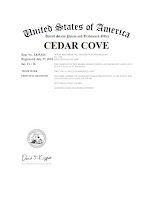 |
Conducting a Title Search
A knockout search is an initial trademark clearance search designed to help identify identical or closely resembling marks. Here's how to conduct one:
- Search the Trademark Office's free online database of pending and federally registered trademarks
- Look for identical and similar marks for related goods or services
- Supplement your search with a Google search to help identify unregistered marks not found in the Trademark Offfice's database.
- If you intend to register your trademark, the Trademark Office recommends working with a trademark attorney.
The focus of your analysis is the likelihood the public will believe your book was published or approved by someone else, including a well-known brand owner. The most important likelihood of confusion factors are (a) the similarity of the marks, (b) the relatedness of the goods or services, which could be a book series, a podcast series, an online course, consulting or coaching services), and (c) the marketplace strength of the mark.
If the title you've selected is already registered by someone for related goods or services, absent a First Amendment defense, soldier on and choose another title. If they cared enough to register their mark, there's a good chance they are prepared to fight to protect it.
When Authors Can Use Protected Names in Book Titles
Not every use of a trademark (or similar title) without permission is an infringement. There are many legitimate reasons to use a particular word or phrase in the title of a creative work that doesn't have anything to do with trading on another party's goodwill, fame, or reputation.
Most nonfiction book titles simply describe the contents of the book. Words that merely describe the contents of a book are, at best, weak trademarks and receive no protection without proof that consumers associate them with a particular source. By "source," the Trademark Act refers to the source of the physical or virtual goods rather than the author. While single titles are not entitled to trademark registration if a single title attains secondary meaning -- a level of commercial magnetism associated with runaway bestsellers -- it can be protected. In analyzing whether a title infringes a trademark or another title, courts balance the right to speak freely against the rights of the trademark owner. While using a disclaimer (the subject of a future post) is not a magic bullet, a prominent disclaimer can help reduce the potential for consumer confusion. For additional tips on selecting a book title, click here.A Warning Before You Start Your Search
Because of the malleability of trademark law, evaluating a search report is as much an art as a science. Put another way, the decision to move forward may come down to how much risk you are willing to take, which is a business decision informed by the quality of the search and the legal analysis. When in doubt, consult a trademark attorney. Your trademark attorney will advise if your mark is even registerable as a trademark. Additionally, they will help you navigate the trademark registration maze.
How to Protect a Book Title
Once you have selected your title, you or your attorney can file either an Intent to Use trademark application or one based on actual commercial use online at www.uspto.gov. Assuming your application meets the minimum filing
requirements, it will be assigned to an examining attorney for review. If there are irregularities with the application, the examiner will
issue an Office Action. An Office Action states the
legal basis for a refusal to register. Some refusals are relatively
easy to overcome, e.g., unacceptable specimen refusals and improper
description of goods and services.
Pro Tip. A standalone book title cannot be registered as a trademark unless it is later used for a series of works (e.g., Harry Potter #1, Harry Potter #2). While you can't register a single book title, you may be able to register the trademark used by the business behind the book. So, for example, if consumers reasonably assume that the owner of a fashion consulting was the author of a book on fashion design and marketing, but they weren't, that confusion may rise to the level of unfair competition.
Substantive refusals include confusingly similar to a mark in an existing registration or pending application. Since a trademark must be distinctive, another common refusal is the mark merely describes an ingredient, quality, characteristic, function, feature, purpose, or use of the goods or services covered in your application. Refusals to register are par for the course. Some can be overcome by cogent legal arguments. However, those with fatal flaws cannot. If the objection is minor, the trademark examiner may call you or send you an informal email requesting information. But, because trademark examiners cannot provide legal advice, the Trademark Office recommends that you use the services of a law firm familiar with Trademark Office practices.
A federal trademark registration can last forever, provided timely renewal applications are filed, and the mark remains distinctive for the goods or services it is linked to.
Only with federal registration may you use the coveted ® symbol. If your mark is unregistered, you may use a superscript ™ after the mark. While trademark notices are not legal requirements, they have legal significance. Like a "No Trespassing" sign, a trademark notice gives notice of your rights. That makes asserting a good faith defense more difficult for a trademark infringer. While willfulness is not a precondition to a profit award, willful infringers are treated more harshly than innocent ones, including, in exceptional cases, awarding attorneys' fees.
Pro Tip. While the first book in a series cannot be registered, the Trademark Office will allow an author to file a trademark application on an Intent to Use basis. Assuming your application meets the minimum filing requirements when the second book in the series is published and a Statement of Use is filed, the Trademark Office will re-evaluate the application. A key benefit of having an Intent to Use application is the filing date will serve as the date of first use if you complete the registration process. Another advantage is your application will block other later filed trademark applications for identical or confusingly similar marks for related goods, including series titles.When you obtain the registration for your title, the original filing date will serve as the date of first use. That gives you priority over those who began using the trademark after your filing date.
Related Posts
Common Copyright Permission Myths
© 2022 Lloyd J. Jassin COPYLAW is a service mark of Lloyd J. Jassin
DISCLAIMER: This article discusses general legal issues of interest and is not designed to give specific legal advice pertaining to specific circumstances. Professional legal advice must be obtained before acting upon any of the information contained in this article.


No comments:
Post a Comment